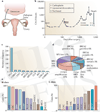Rethinking ovarian cancer II: reducing mortality from high-grade serous ovarian cancer
- PMID: 26493647
- PMCID: PMC4892184
- DOI: 10.1038/nrc4019
Rethinking ovarian cancer II: reducing mortality from high-grade serous ovarian cancer
Abstract
High-grade serous ovarian cancer (HGSOC) accounts for 70-80% of ovarian cancer deaths, and overall survival has not changed significantly for several decades. In this Opinion article, we outline a set of research priorities that we believe will reduce incidence and improve outcomes for women with this disease. This 'roadmap' for HGSOC was determined after extensive discussions at an Ovarian Cancer Action meeting in January 2015.
Figures



References
-
- Mehra K, et al. STICS, SCOUTs and p53 signatures; a new language for pelvic serous carcinogenesis. Front. Biosci. (Elite Ed) 2011;3:625–634. - PubMed
-
- Lee Y, et al. A candidate precursor to serous carcinoma that originates in the distal fallopian tube. J. Pathol. 2007;211:26–35. - PubMed
-
- Piek JM, et al. Dysplastic changes in prophylactically removed Fallopian tubes of women predisposed to developing ovarian cancer. J. Pathol. 2001;195:451–456. - PubMed
Publication types
MeSH terms
Grants and funding
- R01 CA182832/CA/NCI NIH HHS/United States
- R01 CA111882/CA/NCI NIH HHS/United States
- G0902418/MRC_/Medical Research Council/United Kingdom
- ETM/92/CSO_/Chief Scientist Office/United Kingdom
- 16354/CRUK_/Cancer Research UK/United Kingdom
- 15601/CRUK_/Cancer Research UK/United Kingdom
- SCD/11/CSO_/Chief Scientist Office/United Kingdom
- 16561/CRUK_/Cancer Research UK/United Kingdom
- G0501974/MRC_/Medical Research Council/United Kingdom
- MR/K02700X/1/MRC_/Medical Research Council/United Kingdom
- R01 CA168900/CA/NCI NIH HHS/United States
- 16491/CRUK_/Cancer Research UK/United Kingdom
LinkOut - more resources
Full Text Sources
Other Literature Sources
Medical
Molecular Biology Databases

